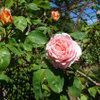The Ingenious Mr. Fairchild...again
bart_2010
10 years ago
Related Stories

LIFEHouzz Call: Show Us Your Nutty Home Fixes
If you've masterminded a solution — silly or ingenious — to a home issue, we want to know
Full Story
LIFEYou Showed Us: 20 Nutty Home Fixes
We made the call for your Band-Aid solutions around the house, and you delivered. Here's how you are making what's broken work again
Full Story
BEFORE AND AFTERSReader Project: California Kitchen Joins the Dark Side
Dark cabinets and countertops replace peeling and cracking all-white versions in this sleek update
Full Story
REMODELING GUIDESYou Won't Believe What These Homeowners Found in Their Walls
From the banal to the downright bizarre, these uncovered artifacts may get you wondering what may be hidden in your own home
Full Story
LIFE'Not My Precious Books!' — Pain-Free Ways to Declutter Your Library
Have your books and neatness too, with these ideas for paring down and straightening up a beloved collection
Full Story
FUN HOUZZThe Narrowest House in the World?
This 4-foot-wide workshop has eating, sleeping and working spaces in its 150 square feet. Chime in on how livable you find it
Full Story
KITCHEN DESIGNKitchen of the Week: Grandma's Kitchen Gets a Modern Twist
Colorful, modern styling replaces old linoleum and an inefficient layout in this architect's inherited house in Washington, D.C.
Full Story
MOST POPULAR50 Shades of Gray
Gray is hotter than ever, thanks to a hit novel full of risks and dark secrets. Tell us: Which paint shade possesses you?
Full Story
SMALL HOMESHouzz Tour: A Student's Bed-Size Shelter in the Arizona Desert
Could you sleep in such a small space just above the desert floor? One Taliesin architecture student at a time does just that
Full Story
FUN HOUZZGeek Lab: How to Build a Steampunk Cat Transit System
Give your kitty another avenue for fun with a tubular walkway system that lets him go his own way
Full StoryMore Discussions











mendocino_rose
strawchicago z5
Related Professionals
Franconia Landscape Architects & Landscape Designers · Surprise Landscape Contractors · Alpharetta Landscape Contractors · Arden-Arcade Landscape Contractors · Gurnee Landscape Contractors · Homewood Landscape Contractors · Lemoore Landscape Contractors · Plantation Landscape Contractors · Whitehall Landscape Contractors · Reisterstown Landscape Contractors · Eatontown Swimming Pool Builders · Englewood Swimming Pool Builders · San Dimas Swimming Pool Builders · Kirkland Siding & Exteriors · Woodbridge Siding & Exteriorsingrid_vc so. CA zone 9
bart_2010Original Author
floridarosez9 Morgan
strawchicago z5
Lynn-in-TX-Z8b- Austin Area/Hill Country
Kippy
Lynn-in-TX-Z8b- Austin Area/Hill Country
bart_2010Original Author
strawchicago z5
strawchicago z5
bart_2010Original Author
strawchicago z5
Kippy
Lynn-in-TX-Z8b- Austin Area/Hill Country
Kippy
strawchicago z5
mohavemaria
bart_2010Original Author
Kippy